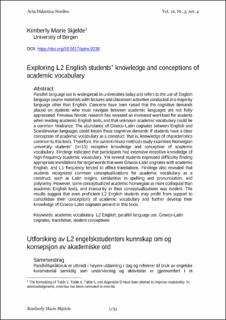| dc.contributor.author | Skjelde, Kimberly Marie | |
| dc.date.accessioned | 2023-01-13T13:53:58Z | |
| dc.date.available | 2023-01-13T13:53:58Z | |
| dc.date.created | 2022-10-18T08:49:39Z | |
| dc.date.issued | 2022 | |
| dc.identifier.issn | 2535-8219 | |
| dc.identifier.uri | https://hdl.handle.net/11250/3043430 | |
| dc.description.abstract | Parallel language use is widespread in universities today and refers to the use of English language course materials with lectures and classroom activities conducted in a majority language other than English. Concerns have been raised that the cognitive demands placed on students who must navigate between academic languages are not fully appreciated. Previous Nordic research has revealed an increased workload for students when reading academic English texts, and that unknown academic vocabulary could be a common hindrance. The abundance of Graeco-Latin cognates between English and Scandinavian languages could lessen these cognitive demands if students have a clear conception of academic vocabulary as a construct, that is, knowledge of characteristics common to this lexis. Therefore, the current mixed-methods study examined Norwegian university students’ (n=13) receptive knowledge and conception of academic vocabulary. Findings indicated that participants had extensive receptive knowledge of high-frequency academic vocabulary. Yet several students expressed difficulty finding appropriate translations for target words that were Graeco-Latin cognates with academic English, and L1 frequency tended to affect translations. Findings also revealed that students recognized common conceptualizations for academic vocabulary as a construct, such as Latin origins, similarities in spelling and pronunciation, and polysemy. However, some conceptualized academic Norwegian as more colloquial than academic English lexis, and insecurity in their conceptualizations was evident. The results suggest that even proficient L2 English students may profit from support to consolidate their conceptions of academic vocabulary and further develop their knowledge of Graeco-Latin cognates present in this lexis. | en_US |
| dc.language.iso | eng | en_US |
| dc.publisher | Acta Didactica Norden | en_US |
| dc.rights | Attribution-NonCommercial-NoDerivatives 4.0 Internasjonal | * |
| dc.rights.uri | http://creativecommons.org/licenses/by-nc-nd/4.0/deed.no | * |
| dc.title | Exploring L2 English students' knowledge and conceptions of academic vocabulary | en_US |
| dc.title.alternative | Utforsking av L2 engelskstudenters kunnskap om og konsepsjon av akademiske ord | en_US |
| dc.type | Journal article | en_US |
| dc.type | Peer reviewed | en_US |
| dc.description.version | publishedVersion | en_US |
| dc.rights.holder | Copyright 2022 the author | en_US |
| dc.source.articlenumber | 4 | en_US |
| cristin.ispublished | true | |
| cristin.fulltext | original | |
| cristin.qualitycode | 1 | |
| dc.identifier.doi | 10.5617/adno.9238 | |
| dc.identifier.cristin | 2062266 | |
| dc.source.journal | Acta Didactica Norden (ADNO) | en_US |
| dc.identifier.citation | Acta Didactica Norden (ADNO). 2022, 16 (3), 4. | en_US |
| dc.source.volume | 16 | en_US |
| dc.source.issue | 3 | en_US |

